Fact Sheet 2014–3031
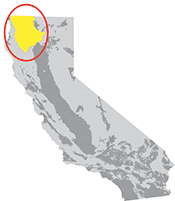
The Klamath Mountains Study Unit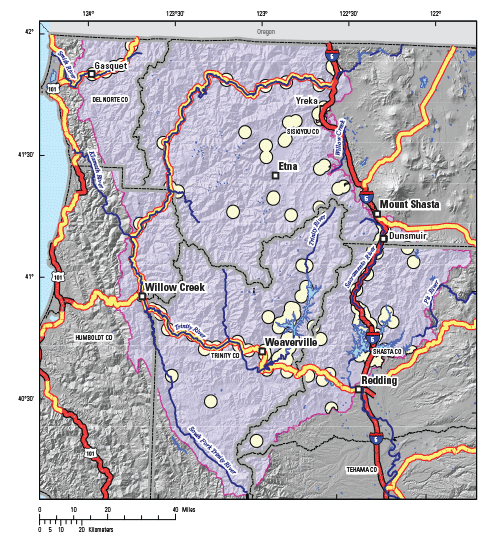
The Klamath Mountains study unit covers more than 8,800 square miles and consists primarily of hard rock terranes characterized by high peaks and deep river gorges with relatively few groundwater basins (Bennett and others, 2014). Most of the study unit consists of metamorphic, ultramafic, and granitic rocks. The primary aquifer system sampled in the study unit, in contrast to most other study units evaluated by the GAMA Priority Basin Project, consisted of localized areas of fractured bedrock. The fracture systems may be interconnected or isolated, resulting in variability in water levels, well yields, and water quality on local and regional scales (California Department of Water Resources, 2003). The primary aquifer system in the study unit is defined as those parts of the aquifer corresponding to the open or perforated intervals of wells listed in the California Department of Public Health (CDPH) database. Drinking water in the Klamath Mountains comes mainly from springs (approximately 18 percent [%] of sampled sites) and wells (approximately 82% of sites) screened in sediment from glacial, alluvial, or fluvial sources. Most wells that were sampled are drilled to depths of 25 to 400 feet, consist of solid casing or seal from the land surface to a depth of about 24 to 300 feet, and are open or perforated below the solid casing or seal. Water quality in the primary aquifer system may differ from that in the shallow and deep water-bearing zones. Land use in the study unit is approximately 97% natural (forest, grasslands, and bare rock), 2% urban, and 1% agricultural. The study unit has warm, dry summers and cool, moist winters. Average annual rainfall ranges from 69 inches on the western edge of the study unit to 40 inches in the central and eastern parts of the study unit. The study unit is primarily drained by the Klamath-Trinity, Sacramento, and Smith River drainage systems. Groundwater recharge in the study unit occurs from the ambient recharge of runoff and snowmelt that penetrates the bedrock through faults and fractures at higher elevations. The primary sources of groundwater discharge are water pumped for municipal supply, evaporation, and discharge to streams. Overview of Water Quality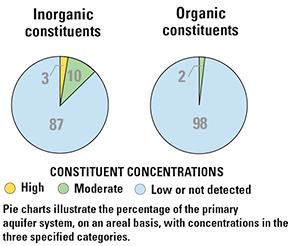
GAMA’s Priority Basin Project evaluates the quality of untreated groundwater. However, for context, benchmarks established for drinking-water quality are used for comparison. Benchmarks and definitions of high, moderate, and low concentrations are discussed in the inset box, “Benchmarks for Evaluating Groundwater Quality”. Many inorganic constituents occur naturally in groundwater, but their concentrations can be affected by natural processes as well as by human activities. In the Klamath Mountains study unit, one or more inorganic constituents were present at high concentrations in about 3% of the primary aquifer system and at moderate concentrations in about 10%. Organic constituents are found in products used in the home, business, industry, and agriculture. Organic constituents can enter the environment through normal usage, spills, or improper disposal. In this study unit, organic constituents were not present at high concentrations in the primary aquifer system, but were present at moderate concentrations in about 2%. RESULTS: Groundwater Quality in the Klamath Mountains Study Unit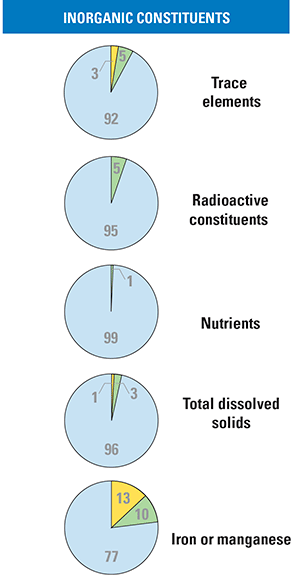
Inorganic Constituents with Human-Health BenchmarksTrace and minor elements are naturally present in the minerals in rocks and soils and in the water that comes into contact with those materials. In the Klamath Mountains study unit, trace elements were present at high concentrations in about 3% of the primary aquifer system and at moderate concentrations in about 5%. Arsenic, antimony, and boron were the trace elements that occurred at high concentrations. Radioactivity is the release of energy or energetic particles during spontaneous decay of unstable atoms. Most of the radioactivity in groundwater comes from the decay of naturally occurring isotopes of uranium and thorium in minerals present in fractures or sediments of the aquifer. Activities of radioactive constituents were not detected at high levels, but were present at moderate levels in about 5% of the primary aquifer system. Nutrients, such as nitrogen, are naturally present at low concentrations in groundwater. High and moderate concentrations generally occur as a result of human activities, such as applying fertilizer to crops and landscaping, seepage from septic systems, and from human and animal waste. In the Klamath Mountains study unit, nutrients were not detected at high concentrations, but were present at moderate concentrations in about 1% of the primary aquifer system. Inorganic Constituents with Non-Health Benchmarks(Not included in water-quality overview charts above) Some constituents affect the aesthetic properties of water, such as taste, color, and odor, or may create nuisance problems, such as staining and scaling. The State of California has a recommended and an upper limit for total dissolved solids (TDS) in drinking water. All groundwater naturally contains TDS as a result of the weathering and dissolution of minerals in soils. Iron and manganese occur naturally in minerals in rocks and soils. Anoxic conditions in groundwater (very low amounts of dissolved oxygen) may result in release of iron and manganese from minerals into groundwater (Hem, 1985). In the Klamath Mountains study unit, TDS was present at high concentrations (greater than the upper limit) in about 1% of the primary aquifer system and at moderate concentrations (between the recommended and upper limit) in about 3%. Iron and (or) manganese were present at high concentrations in about 13% of the primary aquifer system and at moderate concentrations in about 10%. 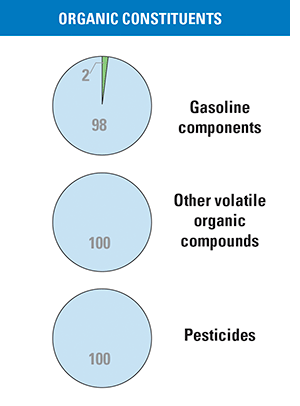
Organic ConstituentsThe GAMA Priority Basin Project uses laboratory methods that can detect low concentrations of volatile organic compounds (VOCs) and pesticides, far below human-health benchmarks. VOCs and pesticides detected at these low concentrations can be used to help trace water from the landscape into the aquifer system. Volatile Organic Compounds with Human-Health BenchmarksVOCs are used in many household, commercial, industrial, and agricultural products and are characterized by their tendency to volatilize (evaporate) into the air. In the Klamath Mountains study unit, VOCs were not present at high concentrations in the primary aquifer system. One component of gasoline, the gasoline oxygenate methyl tert-butyl ether (MTBE), was present at moderate concentrations in about 2% of the primary aquifer system. Gasoline components (additives and oxygenates) increase the efficiency of fuel combustion. Other VOCs include solvents, trihalomethanes, refrigerants, and organic synthesis reagents. Solvents are used for a number of purposes, including manufacturing and cleaning. Trihalomethanes can form during disinfection of water supplies and may enter groundwater by the infiltration of landscape irrigation water or leakage from distribution lines. Other VOCs were not detected at high or moderate concentrations in the primary aquifer system. Solvents, trihalomethanes, and refrigerants were infrequently detected at low concentrations in the primary aquifer system. Pesticides with Human-Health BenchmarksPesticides, including herbicides, insecticides, fungicides, and fumigants, are applied to crops, gardens, lawns, around buildings, and along roads to help control unwanted vegetation (weeds), insects, fungi, and other pests. In the Klamath Mountains study unit, pesticides were not detected at high or moderate concentrations in the primary aquifer system, although herbicides were infrequently detected at low concentrations. BENCHMARKS FOR EVALUATING GROUNDWATER QUALITY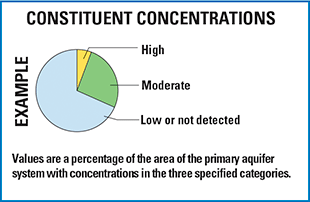
GAMA’s Priority Basin Project uses benchmarks established for drinking water to provide context for evaluating the quality of untreated groundwater. After withdrawal, groundwater may be disinfected, filtered, mixed, and exposed to the atmosphere before being delivered to consumers. Federal and California regulatory benchmarks for protecting human health (Maximum Contaminant Level, MCL) were used when available. Otherwise, non-regulatory benchmarks for protecting aesthetic properties, such as taste and odor (Secondary Maximum Contaminant Level, SMCL), and non-regulatory benchmarks for protecting human health (Notification Level, NL, and Lifetime Health Advisory, HAL) were used. High, moderate, and low concentrations are defined relative to benchmarksConcentrations are considered high if they are greater than a benchmark. For inorganic constituents, concentrations are moderate if they are greater than one-half of a benchmark. For organic constituents, concentrations are moderate if they are greater than one-tenth of a benchmark; this lower threshold was used because organic constituents are generally less prevalent and have smaller concentrations relative to benchmarks than inorganic constituents. Low concentrations include non-detections and values less than moderate concentrations. Methods for evaluating water quality are discussed by Bennett and others (2014). Iron and Manganese in the Klamath Mountains Study UnitNo constituents having health-based benchmarks were present at high concentrations in more than 3% of the Klamath Mountains study unit primary aquifer system. In contrast, iron was present at concentrations above the aesthetic-based secondary maximum contaminant level (SMCL) benchmark of 300 micrograms per liter (µg/L) in about 8% of the primary aquifer system, and manganese was present at concentrations above the SMCL of 50 µg/L in about 11%. Iron and manganese were present at high concentrations in 7 to 31% of the primary aquifer systems in most USGS-GAMA study units statewide. Although harmless at concentrations typically found in natural waters, high concentrations of iron and manganese in groundwater may cause metallic-tasting and (or) foul-smelling water that produces black, brown, or reddish staining of surfaces that come in contact with the water. In the Klamath Mountains study unit, high concentrations of iron and manganese were associated with low dissolved oxygen concentrations and groundwater having longer residence times in the aquifer (Bennett and others, 2014). Concentrations of iron and manganese in groundwater are strongly controlled by the oxidation-reduction conditions. Minerals containing iron and manganese commonly dissolve more easily in groundwater with low amounts of dissolved oxygen (called reducing conditions). In addition to reducing conditions, production of high concentrations of iron and manganese in groundwater also requires sufficient amounts of minerals containing iron and manganese in the aquifer rocks and sufficient time for the minerals to dissolve. The conditions that are the most conducive to manganese and high iron concentrations in groundwater were relatively rare in the Klamath study unit, with well-oxygenated modern-age groundwater occurring most frequently. 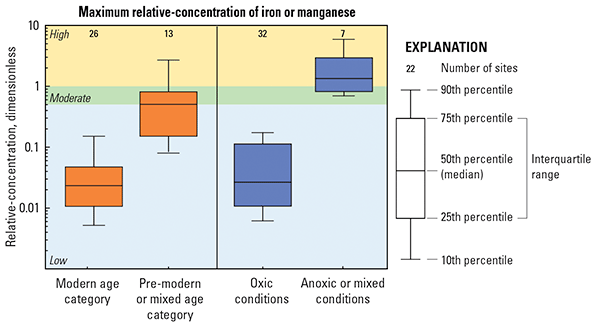
Priority Basin AssessmentsGAMA’s Priority Basin Project (PBP) assesses water quality in that part of the aquifer system used for drinking water, primarily public supply. Water quality in shallower and deeper parts may differ from that in the primary aquifer system. GAMA’s Domestic Well Project assesses water quality in the shallower parts of the aquifer system. Ongoing assessments are being conducted in more than 120 basins throughout California. The GAMA-PBP assessments are based on comparisons of constituent concentrations in untreated groundwater with benchmarks established for the protection of human health and for aesthetic concerns. The GAMA-PBP does not evaluate the quality of drinking water delivered to consumers. The GAMA-PBP uses two scientific approaches for assessing groundwater quality. The first approach uses a network of wells to statistically assess the status of groundwater quality. The second approach combines water-quality, hydrologic, geographic, and other data to help assess the factors that affect water quality. In the Klamath Mountains study unit, data were collected by the GAMA-PBP in 2010 and from the CDPH database for 2007–2010. The PBP includes chemical analyses not generally available as part of regulatory compliance monitoring, including measurements at concentrations much lower than human-health benchmarks, and measurement of constituents that can be used to trace the sources and movement of groundwater. SELECTED REFERENCESBennett, G.L., V, Fram, M.S., and Belitz, Kenneth, 2014, Status and understanding of groundwater quality in the Klamath Mountains study unit, 2010—California GAMA Priority Basin Project: U.S. Geological Survey Scientific Investigations Report 2014-5065, 58 p. California Department of Water Resources, 2003, California’s groundwater: California Department of Water Resources Bulletin 118, 246 p. Available at http://www.water.ca.gov/pubs/groundwater/bulletin118/bulletin118update2003.cfm Hem, J.D., 1985, Study and interpretation of the chemical characteristics of natural waters (3d ed.): U.S. Geological Survey Water-Supply Paper 2254, 213 p. |
First posted September 5, 2014 For additional information, contact: Part or all of this report is presented in Portable Document Format (PDF). For best results viewing and printing PDF documents, it is recommended that you download the documents to your computer and open them with Adobe Reader. PDF documents opened from your browser may not display or print as intended. Download the latest version of Adobe Reader, free of charge. More information about viewing, downloading, and printing report files can be found here. |
Bennett, G.L., V, and Fram, M.S., 2014, Groundwater quality in the Klamath Mountains, California: U.S. Geological Survey Fact Sheet 2014–3031, 4 p., https://dx.doi.org/10.3133/fs20143031
ISSN 2327-6916 (print)
ISSN 2327-6932 (online)